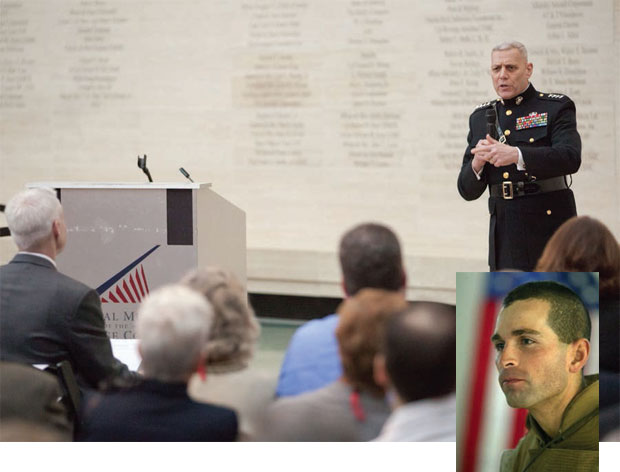In spring 2003, Marine Corps Captain Richard Gannon II ’95 was among the first troops to march into Baghdad at the start of the Iraq War. A year later, on his second combat tour, he and several of his men were killed in a firefight in Husaybah while coming to the aid of a wounded comrade. Thirty-one years old, he left behind a wife and four children.
In recognition of his sacrifice, Gannon was posthumously awarded the Silver Star and promoted to the rank of major. He’s buried in Fort Rosencrans National Cemetery outside San Diego, near where he and his wife, Sally Gannon, went to high school together.

Always faithful: Marine Corps General John Paxton Jr. ’73, MEng ’74, speaks at a tribute to Major Richard Gannon II ’95 in Quantico, Virginia, in March. Gannon (inset) died in Iraq in 2004. Photo: Cpl. Tia Dufour (left); FreedomRemembered.com (right)
In March, a few weeks shy of the tenth anniversary of his death, Gannon was honored in a memorial service at the National Museum of the Marine Corps in Quantico, Virginia. Organized by the Cornell Club of Washington and the Marine Corps Heritage Foundation, the event featured remarks by the Corps’ second-highest-ranking officer: its assistant commandant, General John Paxton Jr. ’73, MEng ’74. “Our leadership principles [are], ‘Know yourself and seek self improvement; know your men and look out for their welfare’—and Rich Gannon did that,” said Paxton, who served with Gannon in the late Nineties, when the latter was a first lieutenant in the First Marine Regiment at Camp Pendleton. “He knew his men and he always looked out for their welfare, including on the seventeenth and eighteenth of April 2004, when he laid down his life for their welfare.”
The memorial also included an introduction by retired Lieutenant General Robert Blackman Jr. ’70 and remarks by President David Skorton, who described Cornell’s long tradition of military training—a requirement of its founding under the Morrill Land Grant Act. When the U.S. entered World War I in 1917, Skorton noted, some 2,000 undergrads enlisted within sixty days—out of a co-ed student body of 5,000. “There’s scarcely anything more important than recognizing service,” he said, “and there’s scarcely a service that can be recognized more profoundly than the one we’re recognizing tonight.”
Attending Cornell on a full scholarship through Naval ROTC, Gannon graduated a semester early with a double major in government and history; he went on to earn a master’s in leadership at the Naval Postgraduate School and teach at Annapolis. The day after he received his officer’s commission, he and his wife were married in a red, white, and blue-themed ceremony: he was born on Memorial Day, she on the Fourth of July. “He exemplified to his last breath, and to us today, all that is best in our Corps—that leadership, that service, that sacrifice,” Paxton said. “It is others before self.”
Gannon is one of two Cornellian service members to die in the post-9/11 wars. Thirty-three-year-old Army Captain George Hood ’93 was killed in Iraq in 2003, when his vehicle was struck by a bomb.
Members of Phi Sigma Kappa fraternity have established the Brother Rick Gannon Memorial Foundation to support the Gannon family. For information, contact majorrickgannonfund@gmail.com.


